Ellis,J. Pressure transients in water engineering, A guide to analysis and interpretation of behaviour
Подождите немного. Документ загружается.


pressure which will be close to the pump’s shut-valve delivery head. Initi-
ally, head in the rising main will exceed the design head. Figure 10.10
shows this for a solo duty pump delivering into a single rising main
carrying treated water. After a delay while the startup compression
pressure wave travels along the main, points along the pipeline are
affected by the pump start and experience a head rise similar to that
at the pump. Figure 10.10 also shows head conditions at the mid-
point of the pipeline, chainage 3.4 km from the pumping station.
After time L=a the pressure wave reaches the downstream end of the
pipeline and a rarefaction wave reflection travels back along the main
towards the pumping station, bringing with it a relief of pressure.
Points further from the pumping station experience this relief of
pressure first, with a fall in head occurring at the mid-point of the pipe-
line. When the reflected pressure wave reaches the pumping station a
fall in head occurs to a lesser extent as the pump operating point
moves to a lower delivery head and higher flow. The pressure waves
continue to travel to and fro in the main, with each wave reflection
producing a fall in pump delivery head and corresponding increase in
flow. Effects of developing pipeline resistance as flow increases gradually
diminish the transient effect, with an almost steady flow occurring after
142
Time (s)
Ch. –0 km
Ch. –3.4 km
Carlops rising main – start of duty pump. Head at pumping station and mid-point of main
Head (mAOD)
0.055
2.255
4.455
6.655
8.855
11.055
13.255
15.455
17.655
19.855
22.055
24.255
26.455
28.655
30.855
33.055
35.255
37.455
39.655
41.855
44.055
46.255
48.455
50.655
52.855
55.055
57.255
59.455
61.655
63.855
400
390
380
370
360
350
340
330
320
Fig. 10.10. Head variations for direct start of solo pump
Pressure transients in water engineering
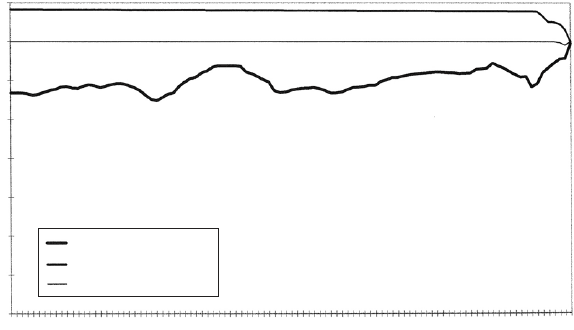
1 min of operation. After the initial upsurge, pressure wave amplitudes
at points further along the pipeline are more noticeable than those at
the pumping station.
As far as overall head change is concerned, Fig. 10.11 shows that the
initial upsurge when the pump is operated creates an almost constant
surge amplitude along the main.
10.7.2 Direct start in multi-pump operation
In a multi-pump installation, the option of starting individual pumps in
sequence is available. A pipeline network is subject to pressure transients
from start of each pump and a sufficient time delay can be incorporated to
allow transient effects from starting of one pump to have decayed to a large
extent before the next pump is started. In this way start-up transient
pressures can be limited and also beneficial effects can accrue by reducing
maximum demand charges for the electrical supply network.
Figure 10.12 shows predicted variations of head in a sewage pumping
system comprising two parallel mains having diameter DN 450 and
DN 600. Two duty pumps are available and these were started in
sequence with a 30 s interval between the start of each pump. Direct
start was used for each pump. When the first pump is operated, head
rises steeply at the pumping station, to a short-lived peak before
falling back by a modest amount. This fall in head is produced by a
143
0
280
560
840
1120
1400
1680
1960
2240
2520
2800
3080
3360
3640
3920
4200
4480
4760
5040
5320
5600
5880
6160
6440
6720
7000
Invert level (i.l.) (mAD)
h (max.)
h (min.)
400
350
300
250
200
150
100
50
0
Chaina
g
e (m)
Carlops rising main. Start of duty pump. Max. and min. head along main
Elevation (mAOD)
Fig. 10.11. Envelope curves for direct start of solo pump
Pumps
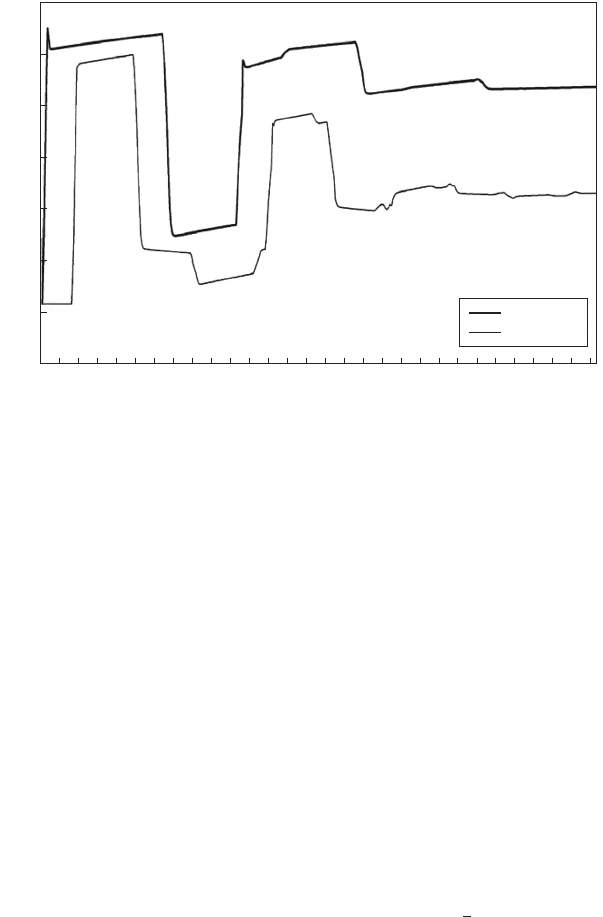
pressure wave reflection from the bifurcation into two mains down-
stream of which there is an overall increase in cross-sectional area.
Thereafter, head starts to rise more slowly. About halfway along the
mains, at chainage 1.525 km, head rises when the pressure wave
reaches this location (Fig. 10.12).
Following reflection of this start-up pressure wave from the outfall
end of the system, head falls within the mains. Those points closest
to the outfall experience the effects of pressure relief first, as at the
mid-point of the mains (Fig. 10.12), with the pumping station being
affected after about 21 s. At 30 s the second pump is operated while
pressure is relatively low at the pumping station, and a second upsurge
pressure wave is created. It will be noted that this second upsurge is
smaller than the first. This is common in multi-pump installations, with
successive pump starts having a progressively smaller effect.
Subsequent wave reflections progressively reduce system pressures
with near-steady conditions achieved after about 1
1
2
min of starting
the first pump. The difference in head between the pumping station
and the halfway point is indicative of pipeline resistance.
Development of flow in the two mains follows a stepped pattern as
shown in Fig. 10.13. Velocity in each main is initially similar but as
144
PS
Ch. 1525 m
Time (s)
Sharjah PS No. 3. Start of two duty pumps with 30 s between starts
Head (mASL)
0.173
3.114
6.055
8.996
11.937
14.878
17.819
20.760
23.701
26.642
29.583
32.524
35.465
38.406
41.347
44.288
47.229
50.170
53.111
56.052
58.993
61.934
64.875
67.816
70.757
73.698
76.639
79.580
82.521
85.462
70
60
50
40
30
20
10
0
Fig. 10.12. Sequenced direct start of two duty pumps
Pressure transients in water engineering
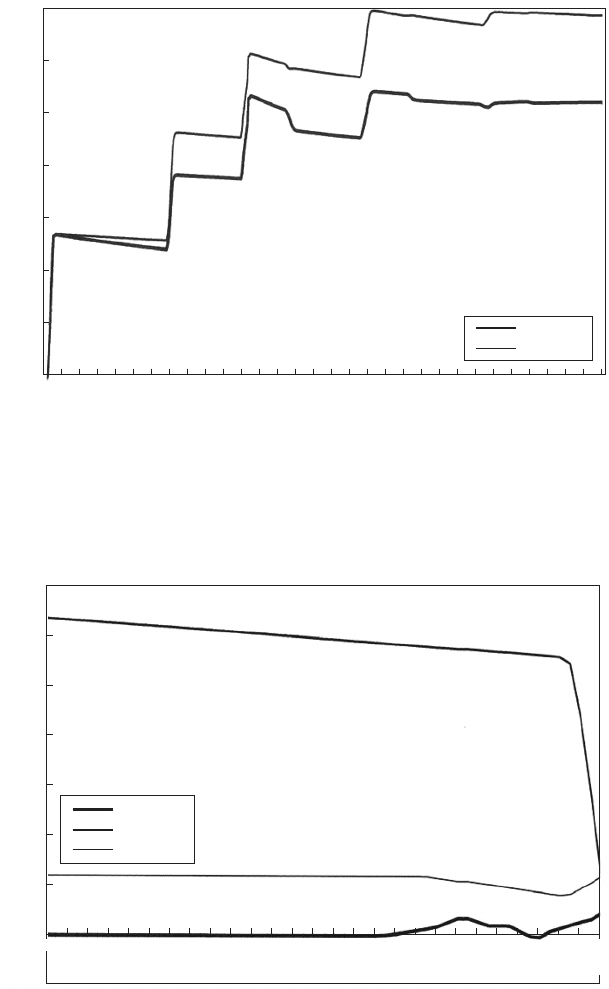
145
3.5
3
2.5
2
1.5
1
0.5
0
0.173
2.941
5.709
8.477
11.245
14.013
16.781
19.549
22.317
25.085
27.853
30.621
33.389
36.157
38.925
41.693
44.461
47.229
49.997
52.765
55.533
58.301
61.069
63.837
66.605
69.373
72.141
74.909
77.677
80.445
83.213
85.981
Time (s)
Ch. 0450
Ch. 0600
Velocity (m/s)
Sharjah PS No. 3. Start of two duty pumps. Velocity variations
Fig. 10.13. Flow development for start of two pumps in sequence
70
60
50
40
30
20
10
0
–10
Elevation (mASL)
Chaina
g
e
(
m
)
Sharjah PS No. 3. Envelope curves for start of two duty pumps
i.l. (mASL)
h (max.)
h (min.)
0
122
244
366
488
610
732
854
976
1098
1220
1342
1464
1586
1708
1830
1952
2074
2196
2318
2440
2501
2623
2745
2867
2989
3111
3233
Fig. 10.14. Envelope curves for direct start of two pumps in sequence
Pumps

their different resistance characteristics start to influence matters, the
larger DN 600 main achieves a significantly higher velocity.
Maximum head along each main shows a gradual fall between the
pumping station and the outfall (Fig. 10.14).
10.8 Initial conditions of flow
In conducting pressure transient studies of pumping systems, as with
gravity pipelines it may simplify matters if the system is started from
rest. This allows static initial conditions to be specified, avoiding the
need to predetermine an initial steady flow condition and hydraulic
gradient. Start-up analyses can also be useful in several respects:
(a) Prediction of start-up transient pressures and time taken for these
transient pressures to decay in order to establish essentially steady
flow.
(b) Determining an appropriate time delay to be allowed between
successive pump starts in a multi-pump installation to avoid any
adverse interaction between surging produced by each pump.
(c) Providing a convenient means of establishing steady flow condi-
tions throughout the network.
Unless particular measures are included to create a ‘soft start’ then
the upsurge developed as a pump is operated will be dependent upon
the pump/motor and system characteristics — that is, dV=dt is not
easily regulated. Likewise, when a pump is tripped, only the energy
contained in the rotating elements
1
2
I!
2
is available to sustain
pumping. In many instances the moment of inertia I is quite modest
and so the amount of stored energy is small, leading to relatively
rapid rates of deceleration and head change at the pumping station.
10.9 Pump failure or ‘trip’
As far as the pipeline system as a whole is concerned, it is important to
examine full station trip or station ‘blackout’ and with a range in system
resistance. These studies will include the maximum pump discharge
using all available duty pumps in an endeavour to find the ‘worst
case’. Other aspects of hydraulic transient behaviour, such as the
response of a check valve following a pump failure, may dictate that
other pump combinations be considered to determine the most critical
event. This aspect is discussed in Chapter 20.
146
Pressure transients in water engineering

Pump trip is an important case for simulation. The initial pressure
drop downstream of a pumping station can produce unacceptably low
pressures but also a subsequent upsurge after flow has reversed is an
important event which requires to be predicted.
In a pumping station containing only a solo duty pump, trip of the
pump will be analysed over the range of suction levels.
In a multi-pump installation wherein several duty pumps may be oper-
ating together it is important to simulate the effect of different numbers of
duty pumps being tripped, again using the pertinent suction levels.
For a multi-pump installation the total amount of stored energy in
rotating elements
1
2
I!
2
varies directly in proportion to the number of
pumps in operation, whereas the increase in flow rate produced by starting
of each additional pump diminishes. The available ‘stored’ energy in
rotating elements per unit of flow, increases as total flow increases.
Thus it is not always obvious which pumping circumstance will produce
the ‘worst case’ as far as the system as a whole is concerned.
When pumping head is relatively high, the deceleration of flow after
pumps are switched off takes place with minimum head downstream of
the pumps remaining above suction levels. In this case the check valves
on each operating pump delivery branch will shut as flow ceases and
starts to reverse. Consider the long water pipeline shown in Fig. 10.15.
Figure 10.16 shows the predicted head downstream of the pumping
station when both operating pumps are tripped simultaneously at
time ¼1 s, simulating a station ‘blackout’. No protection is included
and head falls by almost 200 m at the pumping station over 4 s. At
this time, check valves close on each pump delivery branch. The
head drop is approximately given by aV
o
=g, where V
o
is the initial
steady flow velocity in the rising main. However, head was predicted
to continue falling gradually until around 22 s when the effects of
wave reflections start to influence conditions. This further reduction
in piezometric level is a consequence of pipeline resistance and is a
similar effect to ‘attenuation’ as described in Chapter 7. At 5 km the
effects of pump trip are experienced around 5 s after trip and the
decline in head follows the same pattern as at the pumping station.
The influence of wave reflection is noticeable at around 10 s. At
10 km the falling head is arrested by operation of nearby air valves.
Many pumping systems, particularly sewage schemes, operate at more
modest head and the response of the pumps can be influenced by the
prevailing level in a wet well.
Consider the variations of head shown in Fig. 10.17, downstream of
pumps and part way along sewage rising mains. After all three operating
147
Pumps
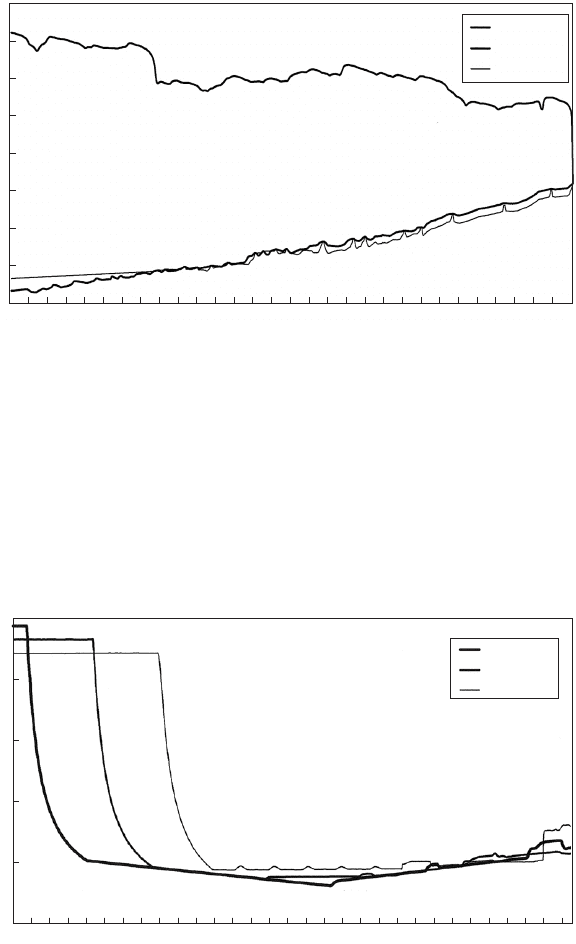
pumps are tripped, delivery head falls steeply until discharge head is
below the suction well level. Under the action of the suction well
level, sewage continues to flow through the pump, keeping the check
valves partially opened. The head downstream of the pumps is largely
148
400
350
300
250
200
150
100
50
0
Head (mPWD)
Chaina
g
e (m)
Az Zour to Wafra Main. Trip of two pumps. Max. and min. head along main
i.l. (mPWD)
h (max.)
h (min.)
0
1153.36
2367.56
3532.11
4751.58
5983.65
7155.67
8448.01
9605.88
10 823.28
11 979.81
13 198.89
14 418.39
15 634.59
16 858.59
18 029.24
19 328.61
20 559.99
21 843.30
23 005.95
24 300.18
25 532.26
26 754.46
28 037.77
29 262.87
30 552.27
31 841.67
33 075.07
34 372.03
35 607.23
Fig. 10.15. Envelope curves for long rising main after pump failure
0.056
1.344
2.632
3.920
5.208
6.496
7.784
9.072
10.360
11.648
12.936
14.224
15.512
16.800
18.088
19.376
20.664
21.952
23.240
24.528
25.816
27.104
28.392
29.680
30.968
32.256
33.544
34.832
36.120
37.408
38.696
250
200
150
100
50
0
Time (s)
Az Zour to Wafra Rising Main. Trip of two duty pumps. Head at PS, ch. 5 km and ch. 10 km
Head (mPWD)
D/s pumps
Ch. 5 km
Ch. 10 km
Fig. 10.16. Head variations in a long rising main after pump failure
Pressure transients in water engineering
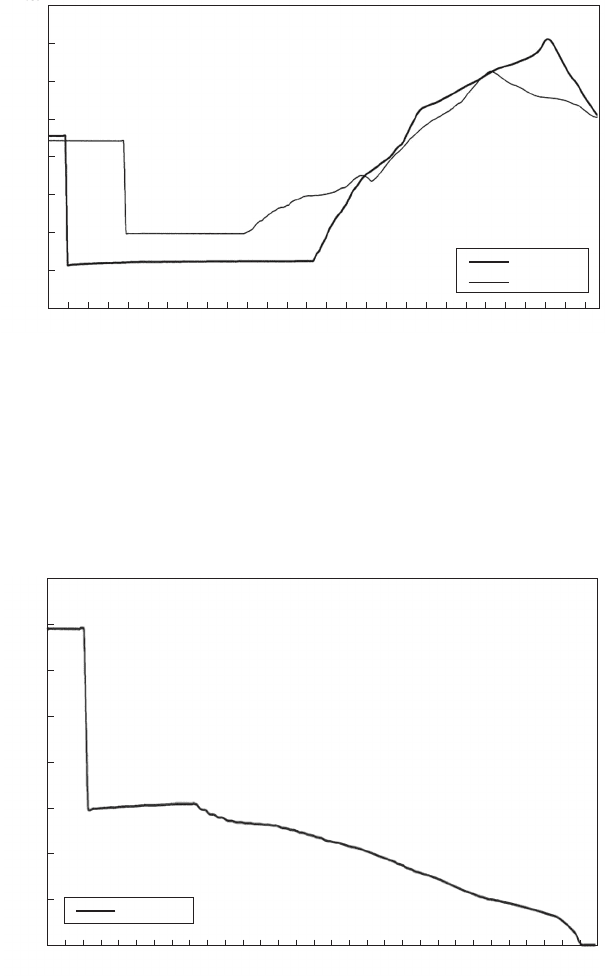
stabilised, showing only a slow and small recovery till around 14 s when
head increases more rapidly. Part way along the mains at chainage
2.6 km the fall in head is similarly halted. Figure 10.18 shows the corre-
sponding variation of velocity at the start of rising mains. Following an
149
0.116
1.160
2.204
3.248
4.292
5.336
6.380
7.424
8.468
9.512
10.556
11.600
12.644
13.688
14.732
15.776
16.820
17.864
18.908
19.952
20.996
22.040
23.084
24.128
25.172
26.216
27.260
28.304
Time (s)
Ch. –0 km
h –2.6 km
Egaila, Kuwait. Simultaneous trip of three pumps. Head at PS and ch. 2.6 km
Head (mPWD)
160
140
120
100
80
60
40
20
0
Fig. 10.17. Simultaneous trip of three pumps in a sewage scheme
Time (s)
Ch. 0.0 m
Egaila, Kuwait. Trip of three pumps. Velocity at start of mains
Time (s)
Velocity (m/s)
0.116
0.580
1.044
1.508
1.972
2.436
2.900
3.364
3.828
4.292
4.756
5.220
5.684
6.148
6.612
7.076
7.540
8.004
8.468
8.932
9.396
9.860
10.324
10.788
11.252
11.716
12.180
12.644
13.108
13.572
14.036
1.6
1.4
1.2
1.0
0.8
0.6
0.4
0.2
0
Fig. 10.18. Velocity changes after trip of three pumps
Pumps
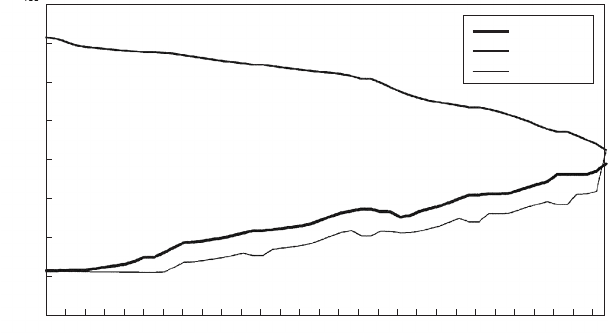
initial steep fall, velocity rises slightly before beginning a relatively
steady decline till around 14 s when the check valves shut. Envelope
curves in Fig. 10.19 show that this system is subject to large vacuum
pressures over most of its length and only the influence of the suction
level has prevented lower head at the pumping station.
10.10 Other pumps
10.10.1 Reciprocating pumps
Principles of operation of a positive displacement pump are relatively
simple. For each working cycle, revolution or stroke, a quantity of
fluid is enclosed and moved from pump intake to outlet. The flow
rate or volume enclosed per cycle is solely dependent upon the dimen-
sions of the displacement pump cavities. Attainable pressure head is
only dependent upon the mechanical strength of the pump and the
available driving power. A safety valve may be incorporated to limit
pressure increase. Figure 10.20 shows a schematic of a piston type of
pump. For many displacement pumps the delivered volume flow
varies during the course of a cycle of operation. The most extreme
example of output variation is that of a single-acting, single-cylinder
piston pump (Fig. 10.21(a)). Smoother flow can be achieved on both
suction and delivery lines by using a number of cylinders in parallel.
150
Egaila, Kuwait. Trip of three pumps. Max. and min. head along mains
Chaina
g
e (m)
Elevation (mPWD)
0
200
400
600
800
1000
1100
1300
1500
1700
1900
2000
2200
2400
2600
2800
3000
3100
3300
3500
3700
3900
4000
4200
4400
4600
4800
4900
5100
160
140
120
100
80
60
40
20
0
i.l. (mPWD)
h (max.)
h (min.)
Fig. 10.19. Envelope curves in a sewage rising main after pump failure
Pressure transients in water engineering
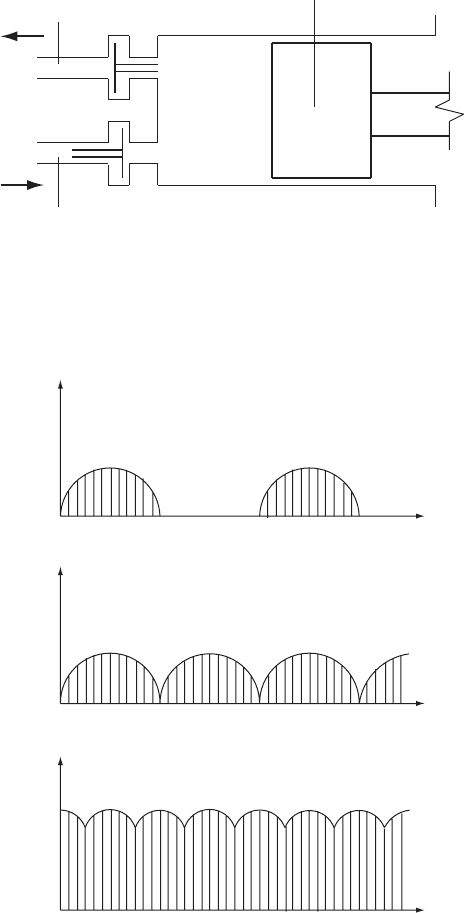
151
Suction
Discharge
Piston
Fig. 10.20. Features of a reciprocating displacement pump
Time
(a)
Time
(b)
Time
(c)
Q
Q
Q
Fig. 10.21. Flow against time relationships for piston pumps: (a) single cylinder
single-acting; (b) twin cylinder single-acting or single cylinder double-acting; (c)
three cylinder single-acting
Pumps
